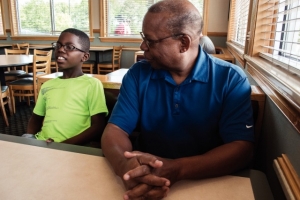Shortage of homes, more children causes foster care program crisis
By Phyllis Moore
Published in News on April 24, 2017 9:49 AM

News-Argus/SETH COMBS
Foster father Edward Davis, right, and 9-year-old Jamario Hawkins sit together at a local restaurant in Kinston Thursday. Davis has been fostering Hawkins for three years and with a history of fostering kids he decided that after retirement he had the time and the desire to help.

News-Argus/SETH COMBS

News-Argus/SETH COMBS
Jamario Hawkins, 9, at the Kinston-Lenoir Public Library with foster father Edward Davis
The foster care crisis around the state is being felt in Wayne County, with growing numbers of children being put into the system and a shortage of homes in which to place them, said Debbie Jones, director of Wayne County Department of Social Services.
North Carolina is also experiencing the shift at an alarming rate, placing foster care and adoption in a "state of crisis," according to the Children's Home Society of North Carolina, the state's largest private provider of foster care and adoption services.
Statewide, the rate of children in foster care in 2016 rose dramatically over the previous year, with more than 2,400 children eligible for adoption. Compounding the problem was the lack of sufficient permanent, safe and loving homes, said Brian Maness, president and CEO of the Children's Home Society.
"About five years ago, we had just over 8,000 children in foster care in our state," he said. "Today there are about 10,500 children in foster care, an increase of more than 25 percent in the last five years."
Mrs. Jones said that Wayne County is keeping pace with that.
"It's probably gone up 36 percent (here)," she said. "Right now, we have 118 children in foster care, meaning in my custody. Forty-eight of those were placed with relatives."
It used to be that family members could be called upon during the interim until a situation could be resolved, Mrs. Jones said. Today that is not always the case.
The rise in substance abuse, as well as opioid use, has changed the landscape in that regard.
"When I first started doing this work, especially in the smaller counties, there was always a grandma, a great-grandma, there was somebody," Mrs. Jones said. "But that has become more and more difficult because of years of substance abuse in families, the crack babies -- we're working with the third-generation children from the crack babies.
"And so when you have all that, substance abuse, the criminal history, you can't place children with these individuals."
About a year ago, federal guidelines were changed, handing down new mandates to states and counties.
"Case management services that were being provided in North Carolina as a whole were, in their opinion, just a different version of putting the children in foster care," she said. "The feds were saying, 'You're just skirting around putting them in foster care.' If they need to be out of the home, if you have put the kid in grandma's home to get the parents to do what they need to do, then you need to be putting them in foster care.
"Every county had made extensive use of what we call 'kinship care' and that has changed. When that changed, that of course sent foster care numbers upwards."
The county currently has 15 foster homes licensed by DSS, which also monitors the homes that serve children from birth to age 21.
There is always a need for foster homes, for a variety of reasons, she said.
"One, the majority of people now who become licensed to foster want to adopt, and they see that as a faster route, which it is," she explained. "Then when they have a child in their home, and they want to adopt, they have their forever family, one or two, whatever it is, they don't foster any more. So there's a constant need for that."
Other foster parents who have been doing it for awhile may age out of the system and also have the right to decline children, she said.
There are also other hurdles, with legalities and issues with the biological parents.
"When they go into foster care, it is the same process as with case management except now there's a court order and there's a judge ordering these parents to get a drug test every week or attend parenting classes or a mental health assessment," she said. "And then there's time frames associated with it.
"We're mandated to have the children in a permanent home within 12 months of removal from the home. That sounds like a long time but when it's difficult to get a mental health appointment or the family doesn't have insurance to pay for that, it can get complicated. And sometimes the parents unfortunately choose the drugs over their children."
Adoptions can happen, she said, but it's a long process. She estimated that probably only one-fourth of those in foster care go on to be adopted.
Once they reach age 18, the child is given the option to remain in the system until age 21. Most choose not to, she said.
One of the biggest needs, though, is how the department responds to emergency situations.
"I would love to have an emergency shelter," Ms. Jones said. "When we get a call at 2 o'clock in the morning, they're busting a meth lab and there's three small children involved that we have to then decontaminate and do all that and find somewhere for them to stay in the middle of the night. It's not at all uncommon that we have to take them to a hotel and stay with them.
"An emergency shelter situation would be just an enormous help."
Wayne County has about 65 individuals doing social work, she said, and that is not limited to working with youth.
"We're mandated to provide protective services for children and disabled adults and the elderly around the clock, all holidays, 24 hours a day," she said. "So that means there's always an adult social worker on call and there's always decisions, there's always a supervisor on call because those decisions require a two-level review -- if you're considering removing children from their home or an elderly individual, you want two heads thinking it through."
Ms. Jones said she is "always on call" as follow-up decision-maker, as is her program manager, Stephen Potter.
The job, in a word, is overwhelming.
Turnover in child welfare has always been on average about two years, she said.
"It's not just the overwhelming nature, it's the investigation," she said. "You can only see so many battered children and dead babies before it really starts to affect you. Social worker burnout is a major problem.
"And adult services now is every bit as intense, which has been a big change in the last 10 or 12 years."
At that end of the spectrum, with things like Alzheimer's being on the rise, it is all numbers driven, she said.
Baby Boomers are now the elderly. People are living longer. And they have more health issues.
"It's not uncommon to see a 70-year-old child trying to take care of a 90-year-old parent," she explained.
She currently has about 100 adult wards under her care, and they don't age out of the system, she said. After 25 years on the job, Ms. Jones' career is wrapping up at the end of this month.It will be hard to leave, she said, but the work will always be there.
